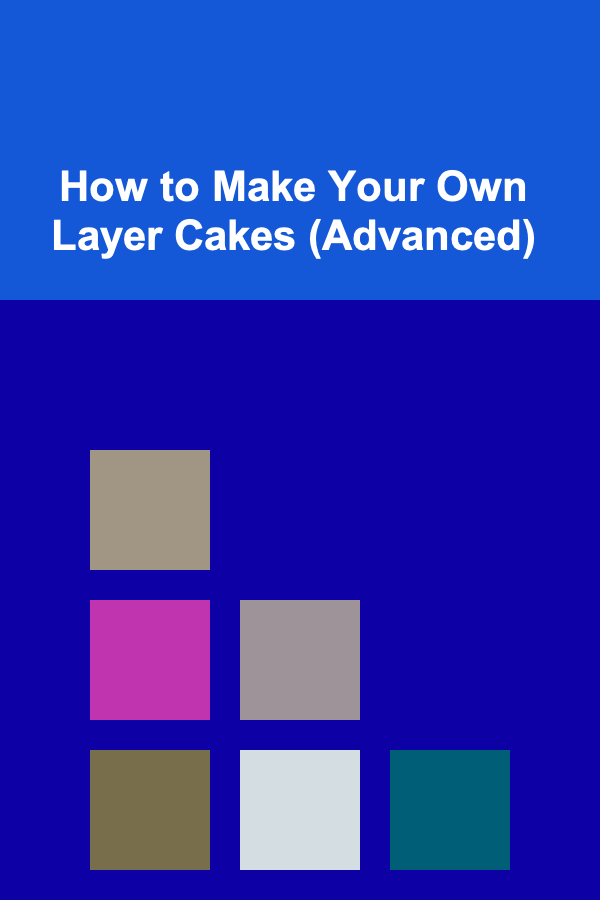
How to Make Your Own Layer Cakes (Advanced)
ebook include PDF & Audio bundle (Micro Guide)
$12.99$7.99
Limited Time Offer! Order within the next:

Layer cakes, with their delicate structure and multiple layers of flavor, are a showstopper in any baking scenario. Crafting the perfect advanced layer cake is both a technical and creative challenge, demanding skill in various areas such as baking, frosting, stacking, and decoration. This guide aims to equip you with the knowledge, techniques, and tips to create stunning, delicious, and impressive layer cakes that will be the centerpiece of any celebration or special occasion.
Understanding the Basics of a Layer Cake
Before diving into advanced techniques, it's essential to understand the basic principles behind a layer cake. A layer cake typically consists of two or more stacked layers of cake, usually separated by a filling and finished with frosting or ganache. The structure of a successful layer cake relies heavily on a few key factors:
- Cake Layers: The foundation of a layer cake is the cake itself. Each layer should be moist, tender, and stable enough to support the weight of subsequent layers and frosting.
- Filling: The filling serves to add flavor and texture contrast between the layers. Fillings can vary from fruit preserves, whipped cream, custards, to flavored buttercreams or ganaches.
- Frosting: The frosting is what holds everything together and provides the exterior texture and visual appeal. It can range from simple buttercream to more intricate designs with fondant or royal icing.
- Decoration: Finally, the decoration elevates the cake into a work of art. This includes techniques such as piping, creating edible flowers, fondant decorations, or even sculptural designs made of sugar.
Step 1: Choosing the Right Cake Recipe
The Cake Layers
The type of cake you choose is critical to the structure and flavor profile of your layer cake. Advanced cake making often involves experimenting with different textures and flavors. Here are some popular options:
- Classic Butter Cake: A rich, buttery cake that has a tender crumb and is excellent for stacking. It pairs well with nearly any filling or frosting and is a go-to for many layer cakes.
- Chocolate Cake: A deep, moist, and flavorful option, chocolate cake can be made with a variety of techniques, from simple cocoa powder-based recipes to more advanced ones using melted chocolate.
- Sponge Cake: Known for its light, airy texture, sponge cake is ideal for cakes that need to be filled with light, whipped creams or mousses. However, it can be trickier to master because of its delicate structure.
- Genoise: A bit more challenging than sponge cake, genoise is a leaner cake (without added fat) and requires skill in mixing and folding to avoid deflating the batter. It works well with luxurious fillings like mascarpone or custards.
- Carrot Cake or Fruit Cake: These options can introduce a twist of flavor and texture to your layer cake, with the added bonus of moistness from ingredients like grated carrots, nuts, or dried fruits.
When choosing a recipe, consider the flavor profile and texture you want for your cake. Remember, the cake must not only taste great but also hold up structurally when stacked and frosted.
Step 2: Advanced Techniques for Preparing Cake Layers
Weighing Ingredients
In advanced baking, accuracy is key. For the best results, always weigh your ingredients instead of using volume measurements. This ensures consistency in texture and flavor and avoids issues like cakes being too dry or dense.
Proper Mixing Techniques
For cakes that rise evenly and have a delicate crumb, the way you mix your ingredients matters. Here are some key tips:
- Creaming Method: This method involves beating the butter and sugar together until light and fluffy, creating air pockets that help the cake rise. This is particularly important for butter cakes.
- Folding: When incorporating dry ingredients or whipped egg whites into a batter, gently fold to maintain the air in the batter and ensure a light texture.
- Don't Overmix: Overmixing the batter can lead to a dense cake. Mix only until the ingredients are just incorporated, especially when using flour-based batters.
Baking Techniques for Even Layers
To achieve perfectly level layers, there are a few techniques you should consider:
- Use Cake Strips: Cake strips, which are dampened fabric strips placed around the outside of your cake pans, help ensure even baking by preventing the edges from setting too quickly, which can cause uneven layers.
- Convection Oven: If you have a convection oven, this can help bake your layers more evenly due to the circulating air. However, if you're using a regular oven, you may need to rotate your cakes halfway through baking.
- Pan Size: Consistently use the same pan size to ensure uniform layers. Make sure to grease and line the pans to prevent sticking.
Cooling and Leveling Cake Layers
Allow your cakes to cool in their pans for about 10-15 minutes before turning them out onto a wire rack. This helps prevent them from breaking apart. Once fully cooled, level the tops of your cakes using a serrated knife or cake leveler to create an even surface for stacking.
Step 3: Preparing Fillings and Frosting
Buttercream
Buttercream is one of the most common frostings for layer cakes due to its versatility and ease of use. There are several types of buttercream to choose from, including:
- American Buttercream: This is a straightforward frosting made with butter, powdered sugar, and flavoring. It's sweet and easy to make but can be overly sugary if not balanced with a touch of salt or acidity.
- Swiss Meringue Buttercream (SMBC): Made by whipping egg whites and sugar to create a meringue, then adding softened butter, SMBC is silky and smooth with a less sweet, buttery flavor.
- Italian Meringue Buttercream (IMBC): Similar to Swiss meringue but with hot sugar syrup poured into whipped egg whites, IMBC is more stable and has a beautiful glossy texture.
- French Meringue Buttercream: Rich and decadent, made with a cooked butter-sugar syrup, it is the least common but offers a lovely, custard-like texture.
Ganache
Ganache, made by combining chocolate and heavy cream, is another popular option for frosting or as a filling between cake layers. For an advanced layer cake, you may choose to make a ganache with different types of chocolate---white, milk, or dark---to create layers of flavor and texture. It's also possible to flavor ganache with liqueurs, vanilla, or spices for extra complexity.
Other Fillings
- Whipped Cream: Light and airy, whipped cream is an excellent choice for filling cakes like sponge or genoise. You can flavor it with vanilla or fold in fruit or chocolate for added richness.
- Fruit Compotes or Preserves: Jam, curd, or fruit compote can be used as fillings to add moisture and brightness to the layers.
- Cream Cheese Frosting: A tangy, thick frosting made with cream cheese, butter, and powdered sugar, perfect for cakes like carrot or red velvet.
Step 4: Assembling and Stacking Your Layer Cake
The assembly process is where your layer cake truly begins to take shape. Here's how to ensure everything stays intact:
Using a Cake Board
A sturdy cake board or a cake base is essential for providing support and making transportation easier. Place a bit of frosting on the cake board to help secure the first layer.
Layering Process
- Start with the First Layer: Place the first cake layer on the cake board. If you've leveled your layers, this will provide a stable base.
- Filling: Add a layer of frosting or filling. Be sure not to overfill, as this can cause the layers to slide or collapse.
- Stacking: Gently press the second cake layer on top. Repeat the process of adding filling and stacking each additional layer.
- Chill Between Layers: Once the first few layers are stacked, place the cake in the fridge to allow the filling to set and help stabilize the structure before continuing with the rest of the layers.
Crumb Coat
A crumb coat is a thin layer of frosting applied to the entire cake to seal in crumbs. This ensures that your final coat of frosting will be smooth and free of cake bits. After applying the crumb coat, refrigerate the cake for 30 minutes to an hour to allow it to set.
Final Layer of Frosting
Once the crumb coat has set, apply the final, thick layer of frosting. Use an offset spatula or a bench scraper to smooth the frosting evenly. This is your opportunity to refine the shape of the cake, making sure it's level and clean.
Step 5: Decorating Your Layer Cake
Advanced Decoration Techniques
Once your layer cake is assembled and frosted, it's time to get creative with decoration. Here are some advanced techniques to consider:
- Piping: Piping intricate designs, such as rosettes, flowers, or borders, can elevate the visual appeal of your cake. Use different tips for various effects, from small dot designs to large swirls.
- Fondant: For a smooth, polished finish, cover your cake with fondant. You can also create intricate flowers, bows, and other decorations from fondant.
- Sugar Flowers: Sugar flowers add elegance and realism to your cake. These can be made from gum paste or fondant and require skill in shaping and assembling petals.
- Gold Leaf or Edible Glitter: Adding edible decorations like gold leaf or edible glitter can provide a luxurious, opulent finish to your cake.
Artistic Techniques
- Drip Cake: Create a stunning effect by dripping ganache or colored icing down the sides of your cake.
- Hand-Painted Designs: For a completely unique and personal touch, you can hand-paint designs using food-safe paints or edible gels.
- Naked Cake: A naked cake, with minimal frosting on the outside, showcases the layers of cake and filling in a rustic yet refined manner.
Conclusion
Making an advanced layer cake requires precision, skill, and creativity. By mastering techniques such as proper cake baking, making silky frostings, and adding intricate decorations, you can create a visually stunning and delicious masterpiece. Whether you're crafting cakes for a special occasion or simply perfecting your baking skills, the ability to create a beautiful, multi-layered cake will set you apart as an advanced baker.

Building Smart Factories: An Industrial Engineer's Approach to Automation and Robotics
Read More
How to Clean Your Windows Without Leaving Streaks
Read More
How to Incorporate Seasonal Decorations into Your Party
Read More
How to Protect Your Pet from Seasonal Allergies
Read More
Understanding the Concept of Opportunity Cost in Spending
Read More
How to Build a Rocket from Scratch: A Beginner's Guide
Read MoreOther Products

Building Smart Factories: An Industrial Engineer's Approach to Automation and Robotics
Read More
How to Clean Your Windows Without Leaving Streaks
Read More
How to Incorporate Seasonal Decorations into Your Party
Read More
How to Protect Your Pet from Seasonal Allergies
Read More
Understanding the Concept of Opportunity Cost in Spending
Read More